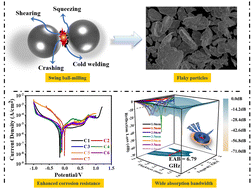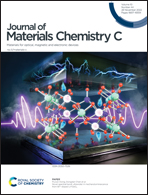Ultrawide-frequency electromagnetic-wave absorption based on FeCoNiCuxMn high entropy alloys synthesized through swing ball-milling†
Abstract
FeCoNiCuxMn (x = 0, 0.1, 0.3, 0.5, 0.7 and 0.9) and FeCoNiCu0.1MnB0.05 high entropy alloys (HEAs) were prepared via an improved swing ball-milling method. The BCC structure and FCC structure coexisted in the HEAs, and the proportion of FCC structure presented an increasing tendency with the increase of Cu content. In terms of corrosion resistance, Cu segregation generated galvanic corrosion, and weakened the corrosion resistance. A small amount of Cu had little effect on the oxidation resistance at high temperatures, but when the Cu content was high (FeCoNiCu0.9Mn), the oxidation resistance of the alloys at 1000 °C was enhanced due to the formation of CuO protective layers. The introduction of boron reduced the oxidation rate and enhanced the initial oxidation temperature but weakened the corrosion resistance and impedance matching. The optimal reflection loss (RLmin) of FeCoNiCu0.1Mn reached −71.0 dB as thin as 2.93 mm, and the widest bandwidth was 6.79 GHz (7.75–14.54 GHz). This work has important significance for the exploration of practical EMA materials that are resistant to harsh environments.

- This article is part of the themed collection: Journal of Materials Chemistry C HOT Papers


 Please wait while we load your content...
Please wait while we load your content...